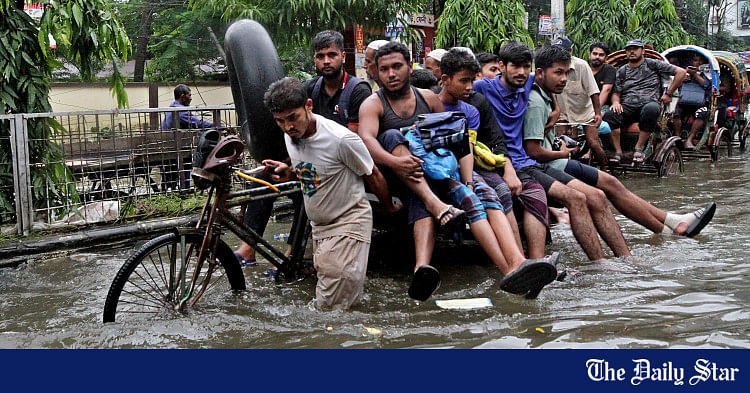Saif
Senior Member
- Joined
- Jan 24, 2024
- Messages
- 15,417
- Nation

- Axis Group


Forecasting flying rivers
The flash floods that struck the north-eastern and south-eastern districts of Bangladesh on August 20 shocked many and confused others about why those (floods) happened at all at a time when the interim government in the wake of a bloody political upheaval had just started its work. Was it to desta
Forecasting flying rivers
SYED FATTAHUL ALIM
Published :
Aug 26, 2024 22:29
Updated :
Aug 26, 2024 22:29

The flash floods that struck the north-eastern and south-eastern districts of Bangladesh on August 20 shocked many and confused others about why those (floods) happened at all at a time when the interim government in the wake of a bloody political upheaval had just started its work. Was it to destabilise the new government that the sluice gate of the Dumbnur dam on the Gumti river in the Indian state of Tripura was opened? However, the Indian authorities denied such allegation suggesting that the gates automatically opened under intense water pressure. True, there was heavy rainfall in that Indian state from August 19 to August 22. So, until there is hard evidence on what actually happened, theories and speculations will fly around. Whatever the case may be, one thing that cannot be denied is that in recent times torrential rainfall has been wreaking havoc in different parts of South Asia. Scientists hold climate change caused by human action responsible for the rise in the number and frequency of such extreme atmospheric events. In these months of the year, frequent rainfalls are not uncommon. But consider that in recent days in parts of Tripura in India and in the eastern districts of Bangladesh, the precipitation was recorded at 200 millimetres. Such high rainfalls within a short span of time may cause rivers to burst their banks or any water control structures such as dams on them. No doubt, it is a new experience for populations in this part of the world.
Of late, climate scientists are coming across frequent occurrences of new types of weather patterns. Those include atmospheric rivers. These are large stretches of water vapour in the form of a column flying as clouds in the lower part of the atmosphere. The amounts of water these flying atmospheric rivers contain can be greater than that in our biggest rivers like Padma, Meghna or Jamuna. And when they come down in the form of heavy rains, what the people experience is nothing short of Noah's deluge. The devastating flood of 2022 (between June and October) that killed more than 1700 people and destroyed properties worth around USD15 billion in Pakistan was said to have been caused by such atmospheric rivers.
Flying rivers, however, are not something new to meteorologists. But what is new is that their number and the frequency of their appearance has increased in the South Asian region. A research report on the phenomenon published in the scientific journal Nature in 2023 said that a total of 574 atmospheric rivers were created between 1951 and 2020. And over the last two decades, 80 per cent of these most severe atmospheric rivers caused floods in India. The Gangetic floodplain called Bangladesh is naturally at the receiving end when such destructive weather events take place in the upstream region. According to a BBC report, scientists from the Indian Institute of Technology (IIT) and the University of California through a study found that between 1985 and 2020, atmospheric rivers had a hand in seven out of the ten of India's most intense monsoon floods. The study further noted that as evaporation from the Indian Ocean has seen a significant increase in recent decades, thanks to the global warming, the number and frequency of floods caused by the flying rivers have also increased proportionately.
The bad news is that the atmospheric rivers are now getting longer, wider and deeper. Usually, an atmospheric river, on average, is about 2000km long, 500km wide and about 3km thick. But we have now even 5000km long flying rivers!
And there is also nothing surprising about that. With the increase in the content of water vapour in the atmosphere, the appearance of atmospheric rivers is increasing. The only way to face this calamity is to increase regional cooperation among South Asian nations to forecast such extreme weather events.
SYED FATTAHUL ALIM
Published :
Aug 26, 2024 22:29
Updated :
Aug 26, 2024 22:29
The flash floods that struck the north-eastern and south-eastern districts of Bangladesh on August 20 shocked many and confused others about why those (floods) happened at all at a time when the interim government in the wake of a bloody political upheaval had just started its work. Was it to destabilise the new government that the sluice gate of the Dumbnur dam on the Gumti river in the Indian state of Tripura was opened? However, the Indian authorities denied such allegation suggesting that the gates automatically opened under intense water pressure. True, there was heavy rainfall in that Indian state from August 19 to August 22. So, until there is hard evidence on what actually happened, theories and speculations will fly around. Whatever the case may be, one thing that cannot be denied is that in recent times torrential rainfall has been wreaking havoc in different parts of South Asia. Scientists hold climate change caused by human action responsible for the rise in the number and frequency of such extreme atmospheric events. In these months of the year, frequent rainfalls are not uncommon. But consider that in recent days in parts of Tripura in India and in the eastern districts of Bangladesh, the precipitation was recorded at 200 millimetres. Such high rainfalls within a short span of time may cause rivers to burst their banks or any water control structures such as dams on them. No doubt, it is a new experience for populations in this part of the world.
Of late, climate scientists are coming across frequent occurrences of new types of weather patterns. Those include atmospheric rivers. These are large stretches of water vapour in the form of a column flying as clouds in the lower part of the atmosphere. The amounts of water these flying atmospheric rivers contain can be greater than that in our biggest rivers like Padma, Meghna or Jamuna. And when they come down in the form of heavy rains, what the people experience is nothing short of Noah's deluge. The devastating flood of 2022 (between June and October) that killed more than 1700 people and destroyed properties worth around USD15 billion in Pakistan was said to have been caused by such atmospheric rivers.
Flying rivers, however, are not something new to meteorologists. But what is new is that their number and the frequency of their appearance has increased in the South Asian region. A research report on the phenomenon published in the scientific journal Nature in 2023 said that a total of 574 atmospheric rivers were created between 1951 and 2020. And over the last two decades, 80 per cent of these most severe atmospheric rivers caused floods in India. The Gangetic floodplain called Bangladesh is naturally at the receiving end when such destructive weather events take place in the upstream region. According to a BBC report, scientists from the Indian Institute of Technology (IIT) and the University of California through a study found that between 1985 and 2020, atmospheric rivers had a hand in seven out of the ten of India's most intense monsoon floods. The study further noted that as evaporation from the Indian Ocean has seen a significant increase in recent decades, thanks to the global warming, the number and frequency of floods caused by the flying rivers have also increased proportionately.
The bad news is that the atmospheric rivers are now getting longer, wider and deeper. Usually, an atmospheric river, on average, is about 2000km long, 500km wide and about 3km thick. But we have now even 5000km long flying rivers!
And there is also nothing surprising about that. With the increase in the content of water vapour in the atmosphere, the appearance of atmospheric rivers is increasing. The only way to face this calamity is to increase regional cooperation among South Asian nations to forecast such extreme weather events.










































